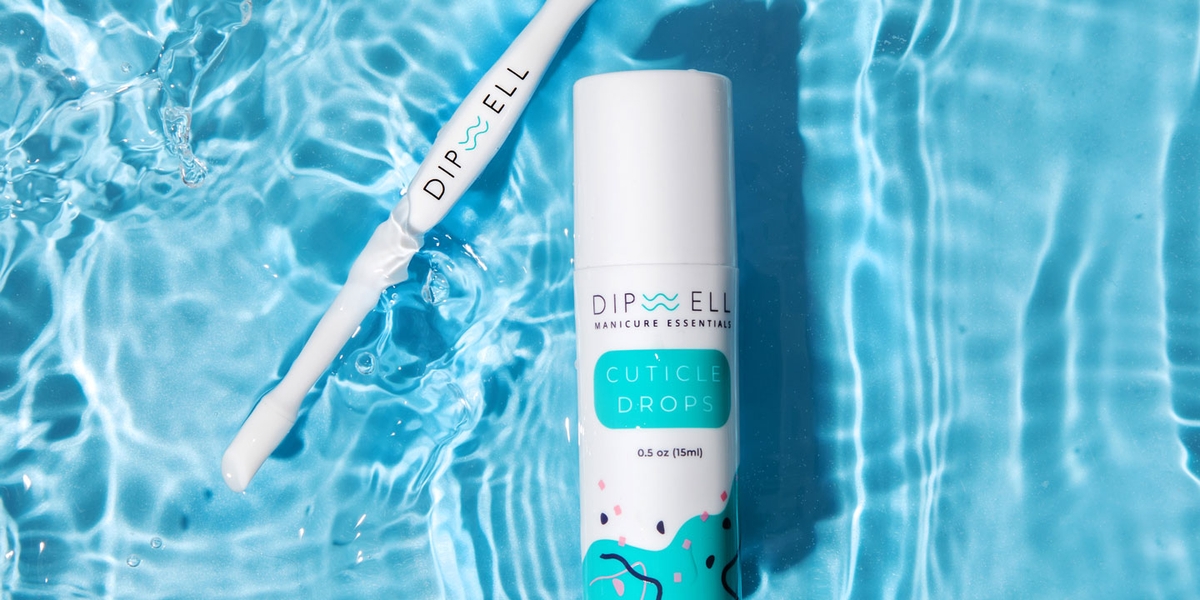Check your cuticles right now... we'll wait.
Do they look pretty banged up?
- Dry, cracked skin around the cuticle line
- Peeling or bleeding cuticle area
- Worst of all, a green or yellow discoloration is present near the cuticles — if it’s not a dip color stain, it’s potentially a sign of an infection or another issue and should be seen by an MD
If your nails are looking rough around the edges, the information in this article will help restore your cuticles to their former gorgeous glory in no time.
But before we let the healing begin, a reminder on why you need to keep your cuticles in tip-top shape.
Why it is important to have healthy cuticles
Cuticles — whether visible or invisible — actually protect your nails against bad bacteria.
(Want to learn all the basics you need to know about cuticles? Check out our Cuticle Care 101 refresher.)
If you're not careful, this protective sealant can get easily damaged. Even a seemingly innocuous activity, such as handwashing, can lead to some pretty beat up cuticles. Other factors that wreak havoc on your cuticles include the cold weather (hello, fall season!), super hot showers (limit it to under 20 minutes, pretty please), and exposure to harsh chemicals (always wear cleaning or gardening gloves).
There's also your compulsive habit of biting your nails or picking your cuticles. Stop it, stat! Lest you want to get those pesky hangnails all the time. And when you do get them, never bite or pull them off because that could only mean one thing: nail cuticle infection galore.
Normally, cuticles that have seen better days will heal on their own in about a week or two. In severe cases, it could take months to treat damaged cuticles (and you'll have to consult your doctor in such instances).
But there are daily habits that will help fix gross cuticles so they don't get worse.
Let's discuss...
Get free tutorials, special deals every week!
Sign up for fresh nail inspo & exclusive discounts delivered right to your inbox.
By subscribing, you acknowledge our Privacy Policy.
How to repair damaged cuticles
1. Opt for old-fashioned washing when possible
While it's convenient to whip out your bottle of hand sanitizer to clean your hands, it's best to go the extra step towards the sink and wash your hands with water instead.
Why?
Because the alcohol content of your favorite hand sanitizer — at least 60% ethyl alcohol for it to be truly effective — may be too harsh on your already dry cuticles and further exacerbate the problem.
If you find it hard to break up with your hand sanitizer, at least make sure it has hydrating ingredients, such as glycerin, aloe vera gel, or essential oils.
(Read more about How To Keep Your Hands Healthy When Using Hand Sanitizer Constantly.)
But remember, when you use a moisturizing hand sanitizer before doing your dip mani, make sure your hands are 100% dry before applying the dipping nail liquids and dip nail powders.
2. Apply cuticle oil every single day
For overall hand care, we can't stress this enough: moisturize as often as possible. There are plenty of hydrating options in the wild for you to choose from — hand creams, hand lotions, and hand serums.
(We've listed the best moisturizers for dry, chapped hands in our Winter Hand Care guide.)
For extra dry cuticles, meet your new cuticle care BFF: Dipwell's Cuticle Drops. You can apply it at least once a day to keep your cuticles hydrated.
Pro tips:
- So you’ll always remember to moisturize, keep the cuticle oil or cuticle drops somewhere near where you normally spend your downtime, like the TV area. It makes it so much easier to moisturize while watching your fave show. Win-win!
- Applying the cuticle at night before bed will give the cuticle oil a chance to penetrate and repair during the night while you sleep.
Lastly, never forget to use cuticle oil AFTER your dip powder manicure is complete.
Here's how you do it:

WATCH THE VIDEO: How to Use Cuticle Oil on a Dip Powder Manicure | DipWell's Cuticle Drops
If you've already bought this dipper favorite before, keep reading because we want to make sure you're using it correctly. In case you haven't noticed, there's a teeny-weeny button on the bottom of the bottle. You give that little bad boy a light press for it to dispense a drop of cuticle oil. That's it! So if you've been squeezing the life out of the Cuticle Drops bottle, whoops, you're doing it wrong.
Now, here's the caveat about cuticle oils. According to Sine, Licensed Cosmetologist and DipWell's Community Educator:
"Our cuticle drops are a great solution. However, if our dippers have sore, raw open bloody cuticles from filing, which I have done to myself, I would suggest cleansing with peroxide and applying bacitracin and a band aid to help heal and avoid an infection. Then once they are relatively healed, then apply our cuticle oil."
3. Check for cuticle damage infections
Notice something green? It may be a case of the greenies. See something yellowish? Let’s hope it’s simply a dip powder color staining on the nails. Worst-case scenario, it may be a fungus. Got any other discoloration? It may be an indication of other health issues. Talk to your physician for the appropriate treatment.
If you have severe cuticle damage, take a break from dipping altogether aside from avoiding cuticle oil. Better safe and infection-free than sorry.
4. Clean your cuticle lines
Always be gentle. That's the one rule you have to follow before a dip powder mani. Going so hard on your cuticles will definitely lead to more painful moments. Ouch!
a. Push back your cuticles
You can use Dipwell's Jelly Pusher or an orange stick. Use your preferred cuticle pusher in a circular motion until all the dead skin is removed from the nail bed. You can also use a micro ball bit with your electric nail drill to gently exfoliate your cuticles.
Here's another option according to Sine:
"You can also file the cuticle line with an emery board. They are thin and easy to get close to your cuticles without ripping them up. A glass file and a metal file work well along the cuticle area also. If you use the thin files and file on the product, you should not cut yourself. If you think the side of your file is too sharp, take another file and run it down the side of it to make it dull."
b. Get rid of the cuticles using a cuticle remover
If simply pushing back your cuticles doesn't work, use a cuticle remover to double down on cuticle removal. The most popular choices among Dipper Club members are the Sally Hansen Instant Cuticle Remover and Blue Cross Cuticle Remover.
c. Trim the excess cuticles with nippers (or the trimmer side of the Jelly Pusher)
Then make sure you wash your hands to remove all debris and wait for your hands to dry completely before applying your dip liquids.
Also, to keep your dip powder mani looking fresh as possible, trim your cuticles as your nails start growing out.
5. Keep your nails clean and healthy
Have a nail brush or toothbrush by the sink and give your nails a good scrub, especially around the edges and underside, to help keep yucky stuff away.
There's another case to be made for happy, healthy cuticles — aside from the fact that you wouldn't want to walk around with unsightly, bloody, and possibly infected cuticles. If you find your dip manicure not lasting for more than a few days, your cuticles might be the culprit.
(Read more about How To Care For Your Cuticles to avoid lifting.)
FAQs: Frequent asked cuticle questions
1. Do you apply cuticle oil before dipping? Or do you just use them in between dips for maintenance?
Never put on cuticle oil before a manicure. If you have moisture or oil on your natural nail bed, lifting can occur quickly. You apply the cuticle oil when your dip manicure is all finished and not during prep.
Pro tip: If you add oils (like coconut oil or olive oil) in the acetone during dip manicure removal, it will leave your hands really moisturized. You can wash your hands with blue Dawn dish soap to remove the oils before starting a new dip application.
2. Does cuticle oil or cream penetrate dip or should I “go naked” once in a while to get my nails healthy and strong?
Regular application of cuticle oil or cuticle cream helps promote nail health and growth. Apply it on a daily basis with your dip on.
3. Does cuticle oil cause lifting?
Cuticle oil per se doesn't cause lifting, especially if the dip is secure. But if there's even just a tiny bit of lifting or imperfection on your dip mani, and then you apply the cuticle oil, it may seep under the dip and help make your nails pop off. In this case, you need to seal them up with a small amount of nail glue until you can redo them. This will also help avoid bacteria from growing under your dip and giving you pseudomonas nail infections.
4. Do you use a peelable base around your cuticles while dipping? Does it help keep your cuticle line smooth? Is it easy to use or more of a hassle than what it’s worth?
Peel base on the cuticles will not help with the cuticle lines. You need to use a toothpick or another pointed tool to get those lines clean.
5. How do you file down the cuticle area more? So that when it grows out, it doesn’t start to catch on to anything.
Short answer: APEX.
Learn how to build an apex with dip powder using this nail apex tutorial.
Dasia, DipWell's Community Educator, is a firm believer in the apex method.
"It helps achieve thinner, cleaner cuticle lines and an overall thinner nail. Make sure you're applying the Step 2 Base in thin coats. Keep in mind that the thicker the coat, the more powder will adhere to your nail. Plus, they will tend to look bumpier."
Ready for some clean, great-looking cuticles?
The kind that gets other dippers to ask, "What’s your secret? How do you heal the skin around your nails?"
All it takes is practice, patience, and time. Just keep trying new tips and tricks for each set until you figure out exactly what works for you.
Share your experience with our Dipper Club members on Facebook or Instagram (via @dipwellnails and the official hashtag: #DoYouDipWell).
Get free tutorials, special deals every week!
Sign up for fresh nail inspo & exclusive discounts delivered right to your inbox!
By subscribing, you acknowledge our Privacy Policy.




